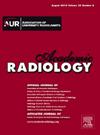Usefulness of [18F]FAPI-04 and [18F]FDG PET/CT for the Detection of Peritoneal Carcinomatosis: A Comparative Study
IF 3.9
2区 医学
Q1 RADIOLOGY, NUCLEAR MEDICINE & MEDICAL IMAGING
引用次数: 0
Abstract
Rationale and Objectives
In this study, we aimed to compared the performance of [18F]FAPI-04 and [18F]fluorodeoxyglucose (FDG) positron emission tomography/computer tomography (PET/CT) in the evaluation of peritoneal carcinomatosis.
Materials and Methods
71 patients with suspected peritoneal malignancies were enrolled in our study. All the participants underwent both [18F]FAPI-04 and [18F]FDG PET/CT imaging within 7 days. The detection rates, diagnostic accuracies, semiquantitative parameters of the tracers, peritoneal cancer index (PCI) scores, and tumor markers were evaluated and compared.
Results
Among the 71 patients, 40 patients were diagnosed with peritoneal carcinomatosis, and 31 were true-negative patients. The sensitivity and accuracy of [18F]FAPI-04 PET/CT were higher than those of [18F]FDG PET/CT (sensitivity: 92.50% vs. 72.50%, p = 0.003; accuracy: 91.55% vs. 80.28%, p<0.001), particularly in patients with gastric cancer. The SUVmax, tumor-to-liver background ratio (TBR-L), tumor-to-descending aorta ratio (TBR-A), and PCI score were significantly higher for [18F]FAPI-04 PET/CT than [18F]FDG PET/CT (all p<0.05). In the [18F]FAPI-04 PET/CT group, the PCI score, TBR-L, TBR-A, TBR-M and SUVmax were higher in the high level group than the low level group (all p<0.05). The carbohydrate antigen 125 (CA 125) levels were strongly correlated with the PCI of both [18F]FAPI-04 and [18F]FDG PET/CT.
Conclusion
[18F]FAPI-04 PET/CT outperformed [18F]FDG PET/CT in the evaluation of peritoneal carcinomatosis, particularly in patients with gastric cancer. Furthermore, [18F]FAPI-04 PET/CT may be used for the assessment of peritoneal carcinomatosis in patients, especially FAPI-PCI.
[18F]FAPI-04与[18F]FDG PET/CT检测腹膜癌的比较研究
基本原理和目的:在本研究中,我们旨在比较[18F]FAPI-04和[18F]氟脱氧葡萄糖(FDG)正电子发射断层扫描/计算机断层扫描(PET/CT)在评估腹膜癌病中的性能。材料和方法:71例疑似腹膜恶性肿瘤患者纳入我们的研究。所有参与者在7天内同时进行[18F]FAPI-04和[18F]FDG PET/CT成像。评估并比较两组的检出率、诊断准确率、示踪剂半定量参数、腹膜癌指数(PCI)评分及肿瘤标志物。结果:71例患者中,确诊腹膜癌40例,真阴性31例。[18F]FAPI-04 PET/CT的敏感性和准确性均高于[18F]FDG PET/CT(敏感性:92.50% vs. 72.50%, p=0.003;准确率:91.55% vs. 80.28%, p18F]FAPI-04 PET/CT高于[18F]FDG PET/CT(均为p18F]FAPI-04 PET/CT组),高水平组PCI评分、TBR-L、TBR-A、TBR-M和SUVmax均高于低水平组(均为p18F]FAPI-04和[18F]FDG PET/CT。结论:[18F]FAPI-04 PET/CT对腹膜癌,尤其是胃癌患者的评价优于[18F]FDG PET/CT。此外,[18F]FAPI-04 PET/CT可用于评估腹膜癌患者的病情,尤其是FAPI-PCI。
本文章由计算机程序翻译,如有差异,请以英文原文为准。
求助全文
约1分钟内获得全文
求助全文
来源期刊

Academic Radiology
医学-核医学
CiteScore
7.60
自引率
10.40%
发文量
432
审稿时长
18 days
期刊介绍:
Academic Radiology publishes original reports of clinical and laboratory investigations in diagnostic imaging, the diagnostic use of radioactive isotopes, computed tomography, positron emission tomography, magnetic resonance imaging, ultrasound, digital subtraction angiography, image-guided interventions and related techniques. It also includes brief technical reports describing original observations, techniques, and instrumental developments; state-of-the-art reports on clinical issues, new technology and other topics of current medical importance; meta-analyses; scientific studies and opinions on radiologic education; and letters to the Editor.
 求助内容:
求助内容: 应助结果提醒方式:
应助结果提醒方式:


